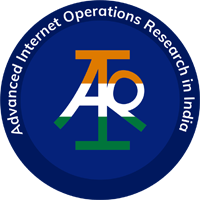The Impact of Quantum Cryptography on DNSSEC and the Way Forward with Post-Quantum Cryptography
The advent of quantum computing poses significant challenges to traditional cryptographic systems, including DNS Security Extensions (DNSSEC). DNSSEC is a suite of extensions to DNS that adds security by enabling DNS responses to be authenticated. However, the cryptographic algorithms that underpin DNSSEC are vulnerable to the computational power of quantum computers. In this blog, we […]
The Importance of the AIORI-IMN Internet Measurement Platform for Different Stakeholders
In today’s interconnected world, understanding the performance and behavior of the Internet is crucial for a variety of stakeholders, from network operators to researchers and policy makers. The Advanced Internet Operations Research in India’s Internet Measurement Network (AIORI-IMN) offers a comprehensive platform designed to meet the diverse needs of these stakeholders. With features such as […]
User-Triggered Reports
Know your latency Explore web service and IP resource latency from over 100 anchor locations with a simple click. Just enter the IP address or domain name to instantly access latency information. This tool empowers users to make informed decisions when selecting a hosting provider, based on performance metrics across different regions. Historical data is […]
Automated Reports of AIORI-IMN
Root Servers DNS Query Latency Visualizer The Root Server DNS Latency Map Visualizer provides a comprehensive view of DNS latency across various regions, allowing stakeholders to monitor and analyze performance metrics in real-time. This tool aggregates data from multiple root servers, presenting latency metrics visually on a geographical map. By visualizing latency trends and fluctuations, […]
Measurements Reports of AIORI.IN
Types of Measurement Reports Available on AIORI.IN Automated Reports Automated measurement reports are generated without user intervention, providing continuous and up-to-date data on various network parameters. These reports are crucial for ongoing network monitoring and early detection of issues. You can view the Root Server Latency Map Visualizer Measurement report directly on the AIORI home […]
DNS Key Trap
The DNS Key Trap According to the National Vulnerability Database Certain aspects of DNSSEC in the DNS protocol, outlined in RFCs 4033, 4034, 4035, 6840, and related documents, enable remote attackers to initiate a denial of service (CPU consumption) through multiple DNSSEC responses, known as the “KeyTrap” issue. One significant concern is that when a […]
Implementing DNS Resolver Security
Introduction DNS resolvers are the backbone of internet connectivity, converting human-readable domain names into IP addresses. For Internet Service Providers (ISPs), ensuring the security of their DNS resolvers is crucial to maintaining the trust and safety of their users. This blog explores the importance of DNS resolver security for ISPs, common threats, and best practices […]
Measuring Latency with Ping: Enhancing Network Performance Insights with AIORI
In the realm of network performance, latency is a crucial metric that reflects the time it takes for data to travel from a source to a destination and back. High latency can degrade user experiences, especially in real-time applications like online gaming, video conferencing, and VoIP. One of the simplest yet powerful tools to measure […]
DNS Security: ZONEMD Ensures the Integrity of Entire DNS Zone Files
The Domain Name System (DNS) is a cornerstone of the internet, translating human-readable domain names into IP addresses. Given its critical role, maintaining the integrity and security of DNS zone files is essential. ZONEMD (Zone Digest) is a novel mechanism designed to enhance the security of DNS by ensuring the integrity of entire zone files. […]
The Role of SPF, DKIM, and DMARC Records in Email Security
Email is a fundamental communication tool, but it is also a common vector for spam, phishing, and other malicious activities. To combat these threats, organizations use various email authentication methods. Three critical technologies in this area are SPF (Sender Policy Framework), DKIM (DomainKeys Identified Mail), and DMARC (Domain-based Message Authentication, Reporting & Conformance). This blog […]
